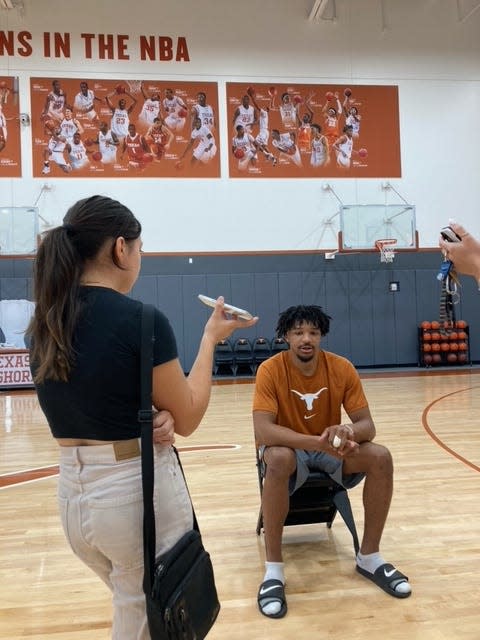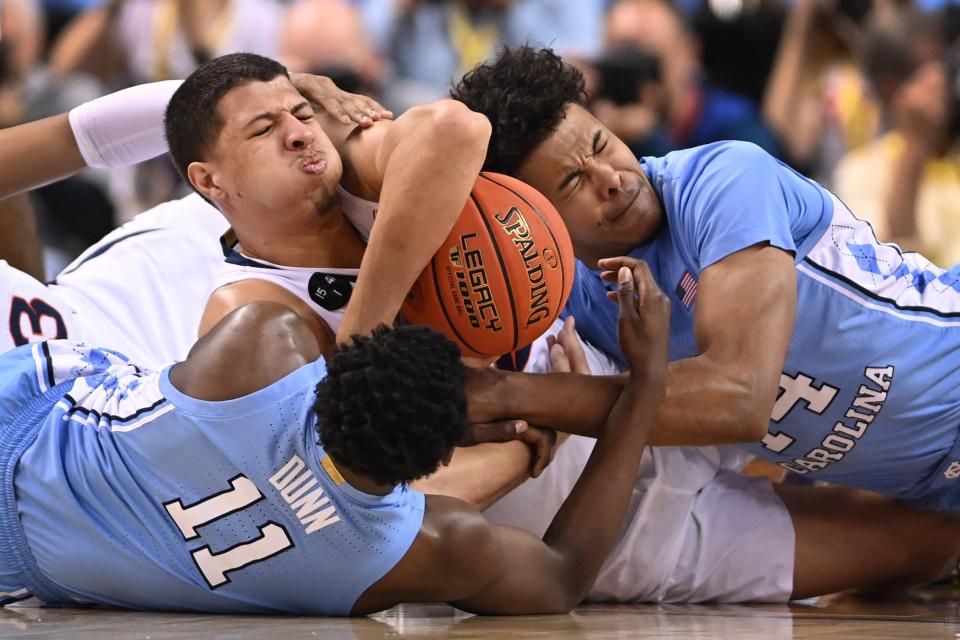New players dreaming big after joining Texas men's basketball program

With official practices now in full swing for the Texas men’s basketball team, newcomer Ithiel Horton has plenty of time to peek up at the panel that stretches across the northern wall of the team’s practice court in Cooley Pavilion.
From McCallum High School graduate and 1960 Olympian Jay Arnette on the far left to current New York Knicks player Jericho Sims on the right, the poster shows all the Longhorns who have been drafted into the NBA.
“Oh, man, I look at that wall every day,” said Horton, a 6-foot-5 guard who played at Central Florida last season. “And I see a spot for me right there, next to Jericho.”
Horton smiled while talking with reporters Wednesday, but his proclamation is no joke. Texas’ success in sending players to the NBA, especially over the past two decades, resonates with recruits, whether they’re coming up from high school or arriving in Austin via the portal.
Of the 48 players in Texas history drafted into the NBA, 21 have come since 2002. Perhaps not coincidentally, that’s when head coach Rodney Terry first joined the program as an assistant to Rick Barnes.
That record of sending players to the NBA is one of the most appealing factors for joining the Texas program, said Horton and Kadin Shedrick, another transfer who arrived in the offseason.
“You’re talking about the guys on that wall — that’s a big reason I’m here,” said Shedrick, a 6-11 forward who spent the past four seasons at Virginia. He then motioned to the far right at pictures of contemporaries such as Sims, Kai Jones, Jaxson Hayes and Jarrett Allen.
“Those guys, that's more of my time,” he said. “Jaxon, Jones, Jarrett, obviously Tristan Thompson. I want to be like them.”
More: From treys to trophies, Texas' Max Abmas ready for lone year with Longhorns

Shedrick hopes to expand skill set
Showing a shooting touch: Shedrick sees some similarities between himself and those big men, who all developed the versatility on both ends of the court that appealed to NBA scouts. He spent his time at Virginia often planted on the block in the Cavaliers’ deliberate offense while anchoring the defense with his rim protection. His playing time seemed to slow, too; last season, he averaged 6.2 points, 3.8 rebounds and 1.4 blocks in 17.5 minutes after playing more than 20 minutes a game the year before.
The more free-flowing offense run by Terry and his staff will allow him to exhibit his skill set, Shedrick said.
“Texas was a school I was always kind of intrigued by,” he said. “There’s a whole bunch of athletic big men that come from here, and I feel like that's something that Texas is really good for. That was something that interested me.”
And what will Texas fans see that perhaps the Virginia fans missed?
“Coming from Virginia, we're known for playing slower,” he said. “Texas plays really high up-tempo. I think that's something I really need to build on, is being able to get out and run for the whole game to get where I want to get to for the next level. I just want an opportunity to play more of a motion offense and still be able to do things that you want in defense.”
Shedrick also showed a nice touch from 3-point range during his youth basketball days in North Carolina, but he attempted just one shot from behind the 3-point line at Virginia.
That will change this season, he said. Terry likes Shedrick’s long-range ability and believes he can space the floor on offense while still protecting the paint, just like the big men in the NBA.
“The goal this year is to be able to come out and stretch the floor some because I can shoot and make 3s,” Shedrick said. “I didn't get to show that at Virginia.”
Added Terry: “You know, Kadin is an elite-level rim protector, but he’s agile guy that can run the floor like a deer. And he has a pretty good skill set.”
More: Texas' final season in Big 12 basketball set as conference releases men's schedule
‘Royal’ treatment could help Horton get to next level
Horton can shoot from long range: Horton, a New Jersey native, isn’t shy about describing his ability to put the ball in the basket during a career in which he’s averaged 11.5 points while shooting almost 40% from 3-point range and over 80% from the foul line.
“That’s what I do,” he said. “I shoot the ball at a high level. And I get to the rim. I just love to score the ball. But I've always played the right way, too. I'm looking for my teammates, but I shoot when I'm open and take good shots.”
He also knows that Terry and his staff stress defensive versatility, which is a major appeal for NBA scouts who already like Horton’s 6-5, 200-pound frame. Perhaps that’s why he cited former Texas guard Royal Ivey — a defensive wizard who grew up in New York City and spent almost a decade in the NBA — as someone on the wall poster in Cooley to emulate.
“I know he was from up north like me, and I know he was smooth,” Horton said.
Terry says Horton has the game to help the Longhorns make another long run in the NCAA Tournament while catching the attention of NBA scouts.
“He can really shoot the basketball, but I think he's more than just a shooter,” Terry said. “We've seen that he can put the ball on the floor and he can be a guy that defends at a very high level.”
Horton’s willingness to defend and Shedrick’s eagerness to expand his offensive game testify to the appeal that the Texas program holds for recruits, Terry said.
“We always talk a lot of times in recruiting about the lineage that we have with Texas basketball,” he said. “Every guy that's really put on this burnt orange and paid the price in sweat and done all the things that it takes into being a player at the University of Texas, they’ll have their chance at the next level.”
Key upcoming dates
Oct. 17: Orange-White scrimmage, Gregory Gymnasium
Oct. 30: Free exhibition game against St. Edward’s, Moody Center
Nov. 6: Season opener vs. Incarnate Word, Moody Center
This article originally appeared on Austin American-Statesman: NBA dreams part of Texas appeal for new men's basketball players
